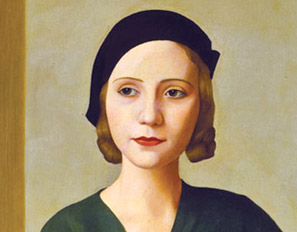Art of the state: fascist Italy’s paintings go on show
An exhibition in Florence strives to present 1930s Italy as a
cauldron of experimentation. Instead, it’s a bleak journey into the
aesthetic lifelessness of a totalitarian society.
In 1938 Adolf Hitler arrived at Santa Maria Novella railway station
in Florence to be greeted by red, white and black swastika banners,
Italian fascist symbols, fake statues and choreographed crowds. He was
taken by Benito Mussolini through this beautiful city of the Italian
Renaissance to admire its masterpieces. Hitler saw himself as an artist.
He had been to art school. Now he communed with Michelangelo while the
masses cheered his every step.
Six years later, in 1944, German troops retreating through Florence
blew up all of its historic bridges except the fabled Ponte Vecchio and
mined the medieval centre. Hitler’s embrace was deadly.
 |
|
Antonio
Donghis Woman at the Cafe (1932) |
It is deadly still. Susan Sontag once published an essay called
Fascinating Fascism. I don’t know about fascination, but the death-force
of fascism, its murder of the human heart, grips a major exhibition in
Florence that sets out to reveal the richness of the arts in 1930s
Italy.
This show slides inexorably into the poisonous cesspit of Europe’s
history.
Anni Trenta (“the 30s”) at the Palazzo Strozzi explores the culture
of Italy under the rule of Mussolini when he and Hitler seemed to many
observers around the world to be the coming men of a new Europe.
Democracy was discredited.
The Depression seemed to have revealed basic flaws in free markets
and elected governments, as the historian Mark Mazower shows in his
profound book Dark Continent. It was the corporate states of fascism
with their massive public projects that appeared to offer a way forward
– unless you were on the left and looked to Stalin’s Russia.
The most terrifying and best part of Anni Trenta is its side-exhibit
about Hitler’s visit to Florence. This captures the true monstrosity of
the era. History is well told here. But does the art of the fascist era
deserve to be reclaimed and enjoyed apolitically?
This is where the exhibition gets in trouble.
Its subtitle is “The Arts in Italy Beyond Fascism”. It strives to
present fascist Italy as a cauldron of creativity where rich experiments
were taking place. It totally fails to make that case. In reality, this
is a depressing, bleak journey through the art of a totalitarian state.
The new Europe of fascism was a dead end. It bred heartless mediocrity.
Paintings of strident men in front of mighty locomotives and chic women
looking icily glamorous do not in the least challenge my assumptions –
in fact they seem to be typical of what you might think fascists would
hang in their galleries.
This show cannot make decadent futurists – their early brilliance
long gone – or conservative neo-classicists any more vital than they
were. What it does reveal, however, is how fascism used art to shape
society in subtle ways. It appreciated the value of a busy, well-funded
official art world. Italian fascism worked through what the communist
thinker Antonio Gramsci – who died in 1937 after years in fascist
prisons – called “hegemony”: by spreading tentacles of involvement
through civil society.
Where this exhibition succeeds is in revealing the fascist
institutionalisation of art. We see paintings that won fascist Italy’s
Bergamo prize, and designs for public art. Art was a component of
fascist society.
The result was a strange, lifeless aesthetic bubble where prizes were
given and artists were promoted for works that were at best muted by
fear, at worst glorying in mad delusion. “Fascism says, ‘Long live art,
let the world die,’” said the German communist Walter Benjamin at the
time.
The art of Italy in the 1930s is an art of the dead. When Hitler was
taken up San Miniato al Monte on his 1938 visit, he said he could
finally understand his favourite painting, Arnold Böcklin’s Isle of the
Dead (which does in fact depict a cemetery on this hill overlooking
Florence).
In a city of beauty, all he responded to was the allure of the grave.
- The Guardian
|





